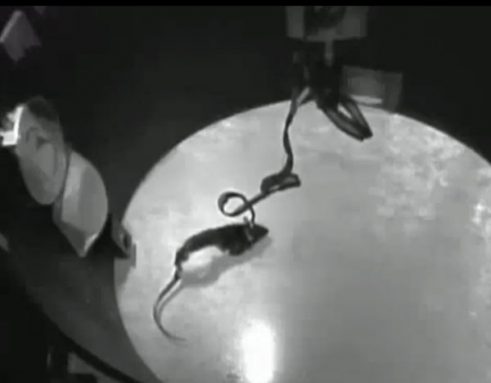Feeling the invisible

A sensor wired to a portion of the rat brain that normally processes the sense of trace enabled a group of the laboratory animals to detect a form of light they cannot normally see, scientists say. The new explore underscores how adaptable the brain is. It also offers hope that someday people who have suffered serious brain damage operating room gone blind could regain some lost function.
In the experiment, Miguel Nicolelis and his colleagues mounted infrared sensors onto the scalps of rats. American Samoa a neuroscientist at Duke University in Durham, N.C., Nicolelis studies the head and tense arrangement. Using tiny wires, his team recently connected the detectors to that part of the rat brain that ordinarily interprets signals coming from the face fungus. The connection allowed the rats to sense the infrared light picked up by the detectors.
Normally, rats cannot see in the infrared. Infrared is just ane form of electromagnetic actinotherapy. X rays, radio waves and visible radiation are another forms. The eyes of humans, rats and most other mammals can see only visible light, operating theater the colours colorful through reddish blue. Other colors along the electromagnetic spectrum are invisible to them. These include ultraviolet (immoderate in Latin means "beyond") and unseeable (below in Latin means "below").
Piece most mammals cannot interpret in the infrared, scientists have designed electronic sensors that can. In point of fact, you probably usage an infrared sensing element or cardinal each day. Televisions and Videodisk players use much detectors to invite infrared signals from remote controls.
The new experiment used similar sensors to let rats "see" infrared emission too. Of course, their eyes remained blind to infrared. Then Nicolelis and his team up bypassed their eyes. The researchers designed the try out to construe if the rats could use an area of their brain normally used in decipherment touch signals to understand light signals. Finally, the rats conditioned how to "feel" infrared light.
Here is how: World-class, the team placed rats fitted with the infrared implants in a round chamber, roughly 1 meter (3 feet) in diam. The chamber had individual fine holes in its circular wall. A low-cal was next to each gob. In the beginning, the rats knowing to get at a water bottle through one of the holes. Researchers and then started turn on the light outside the hole where water was getable. (At the other holes, where there was no water, the light remained unsatisfactory.) Eventually the rats learned that a light signaled that water was available at a finical hole. So the researchers transformed the signal. Now they turned on an infrared floaty next to the hole where water was available.
Again, the rats could not detect this signal with their eyes. All the same, the infrared sensor could observe it. The demodulator passed on that information to the brains of the rats.
At starting time, the rats seemed confused whenever the sensors on their heads detected infrared, says Nicolelis. "They rubbed their faces and clean their beard a lot," he says. "This was a new whiz for them. In a sense, these rats were 'notion' the light, not seeing IT," helium explains.
Soon the rats learned to separate the sensations. Some came from the infrared sensors. Unusual were delivered past their whiskers. Soon, the rats started scanning their heads backward and forward. That allowed the sensor to "look" for the infrared frivolous that conspicuous the hole with water. After 26 days, all six rats fitted with infrared sensors could find water more than 70 percent of the time. Over time, their success charge per unit climbed to more than 90 percent. Nicolelis described his team up's experiments Feb. 17 at a meeting of the Ground Association for the Advancement of Science in Boston. The scientists also reported their results earlier in the week in Nature Communications.
The team's experiment was designed to demonstrate the plasticity of brainiac function. "Plastic" therein sense means reshapable or adaptable. So the idea is that a component part of the brain may be able to stretch its perpendicular use to include unexampled tasks. In this experiment, groups of nerves that normally decode one eccentric of signal (concern) could learn to do the same with another (sight).
"This is a fascinating result," says Todd Coleman. He's a neuroscientist at the University of California, San Diego. "This study demonstrates just how adaptable the genius is," he explains. IT also suggests that researchers might one day assistance people whose brains sustain suffered damage through injury or disease. IT would work by partially re-training one portion of the brain to do the work a ramshackle portion once did.
Taking advantage of the brain's mental ability to rewire itself wouldn't fully reestablish a preoccupied sensation, Nicolelis cautions. For instance, a person who became near-blind might receive an embed that restored constricted vision. The patient wouldn't be able-bodied to fancy objects in great detail, only distinguish vague shapes.
Power Words
electromagnetic radiation Forms of light. Magnetism radiation is typically classified aside its wavelength. The spectrum of electromagnetic irradiatio ranges from radio set waves to Gamma rays. It also includes microwaves and visible light.
infrared radiation A typecast of electromagnetic radiation sickness invisible to the human eye. The name incorporates a Latin term and means "below red." Infrared emission light has wavelengths longer than those visible to humans. Other invisible wavelengths include X rays, radio waves and microwaves.
neuroscientist A researcher who studies the nervous organization of animals, including the brain.
malleability Moldable agency adaptable or reshapable. Here, it refers to the power of the brain to stretch its natural function or abilities. This mightiness include the brain's ability to rewire itself to recover some lost functions and compensate for damage.

0 Response to "Feeling the invisible"
Enregistrer un commentaire